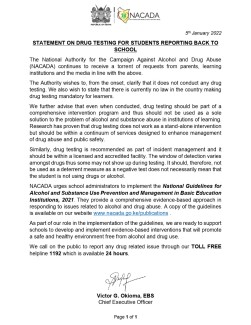Is students’ drug testing the solution to school riots?

The torching of schools by students has become a regular occurrence in Kenya over the past two decades. This has resulted to destruction of property, disruption of the school calendar and unfortunately loss of innocent lives. Last year, another spate of dormitory and school building fires forced the government to adjust the school calendar with a few days.
Outlined as possible causes included exam-related anxiety, schoolwork load, peer pressure, school leadership, lack of guidance and counselling and substance abuse. To remedy the situation, a number of schools directed that students undergo mandatory drug testing and submit certified copies when resuming classes this month. This was probably based on the theory that if the students tested on a regular and random basis will be less likely to do drugs. The problem with this theory is that any scientific evidence does not back it up and there is no one drug test that can test for all the possible drugs.
To remedy the situation, the National Authority for the Campaign Against Alcohol and Drug Abuse (NACADA) issued a statement clarifying when and how drug tests should be used.
The statement sought to clarify that drug testing should be part of a comprehensive intervention. It should not be used a sole solution and as a deterrent measure. Similarly, the statement sought to clarify that drug testing should be part of incident management and within a licensed facility. Further, adequate resources and treatment interventions must be available if the student fails a drug test.
There is also need to consider that the test may be negative if done more than two to three days after the last time drugs were used (window of detection). Drug tests can be negative if the urine sample is overly diluted, substituted with someone else’s sample or if the sample is adulterated, especially if there is no direct observation when giving the sample. The tests can also be seen as an unwarranted, invasion of privacy and may create an environment of resentment, profiling, distrust, and suspicion.
The Kenya National School Health Policy, 2018 commits to promote healthy lifestyles and implementation of interventions to reduce modifiable risk factors for non-communicable diseases and mental health within the school community. Strategies include development, rolling out of guidelines and standards on promotion, prevention, treatment and rehabilitation of persons with mental, and substance use disorders.
Equally, the National Guidelines for Alcohol and Substance Use Prevention and Management in Basic Education Institutions, 2021 explicitly provide a blueprint for basic education institutions, teachers and caregivers in responding effectively to issues related to alcohol and substance use in schools. The guidelines recommend drug testing by an accredited public health facility as part of incident management in cases of suspected alcohol and drug abuse coupled with counselling and involvement of parents or caregivers.
NACADA urged school administrators to be proactive and adopt evidence-based programs that are successful and targeting students, parents/caregivers and the school workplace.
Remember, a negative drug test does not necessarily mean that the students are not using alcohol or drugs. Consider the pros and cons before administering a drug test.